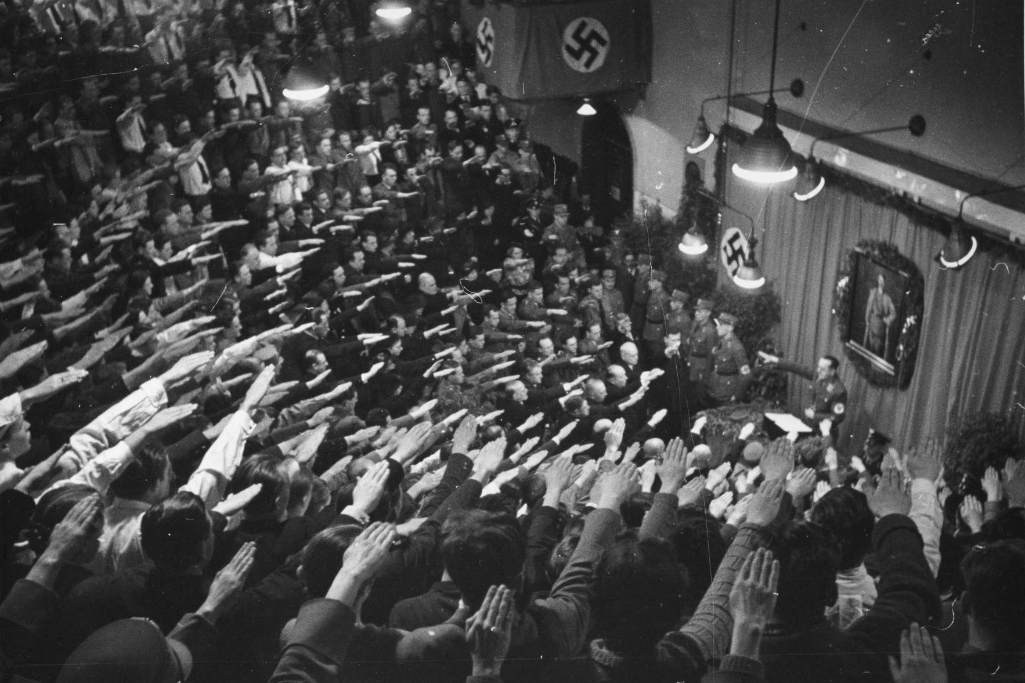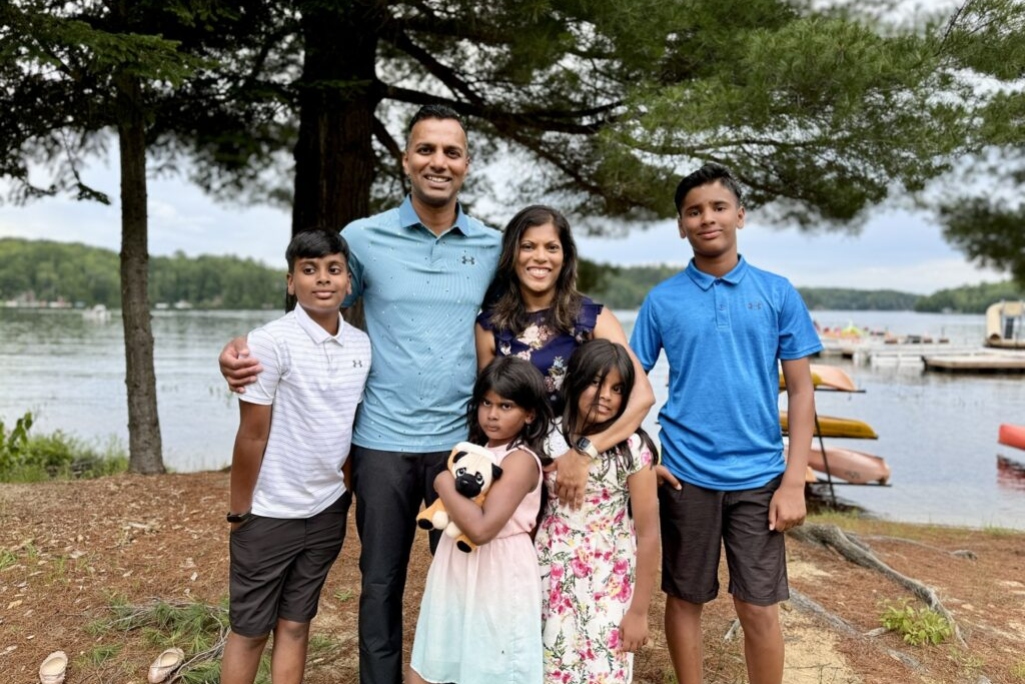
Dr. Eduard Pernkopf, at podium, displays his Nazi allegiance at the University of Vienna in 1938 soon after becoming dean of the medical school. His salute is returned by the faculty. Copyrighted photo from the Austrian National Library. Used by permission.
CEDARVILLE, Ohio — The premier atlas of human anatomy for a half-century had an unfathomable stain: the atrocities of the Holocaust.
The atlas, developed at a Nazi-led medical school in Vienna, utilized the bodies of nearly 1,400 individuals who were killed for its dissections.
When bioethics professor Dennis Sullivan learned about what was called the Pernkopf Atlas in 2001, he joined the sweeping sentiment to rid it from medical education and practice.
And he found joy — two decades later — upon learning of the Amara Yad project — a moral corrective initiated by a professor at UCLA, a native of India who was raised in a Hindu family.
Sullivan, an emeritus professor who has taught at Cedarville University in Ohio for 25 years, describes the efforts of Kalyanam Shivkumar, professor of medicine (cardiology) and radiology at UCLA, as “an exemplar, a role model of moral fortitude in medicine” for leading Amara Yad (pronounced ah-mara-yad).
“Rarely do we see the healthcare profession taking a moral stand to correct an egregious evil,” Sullivan stated. “But that is precisely the lofty purpose of Amara Yad, to mitigate, dare I say obliterate, a horrible medical legacy from the Holocaust.
“This project promotes human dignity and will make our modern world a better place.”
Sullivan, who has never met Shivkumar, learned of the emerging Amara Yad project three years ago.
Amara Yad — named by Shivkumar and his associates as “The Immortal Hand” — combines the word “immortal” in Sanskrit, the foundational language of South Asia, with “yad,” the Hebrew word for hand.
The initiative aims to be an open-access “internet of the human body,” as Shivkumar describes it.
He also calls it “a knowledge portal that is open to the whole world” and “a road map” depicting anatomical intricacies produced by researchers’ use of imaging technology and artificial intelligence in dissecting bodies that people have willed to the project upon their death.
The first of seven volumes on the heart, at 392 pages, was released in 2022 (accessible here). The second volume, at 200 pages, was released in 2024.
Forty human anatomy volumes are planned, with work on the nervous and pulmonary systems underway, now involving partners from such universities as Oxford and the Indian Institute of Science.
Nazis’ grip in Vienna
The seven-volume Nazi-era Pernkopf Atlas, formally titled Atlas of Topographical and Applied Human Anatomy, was produced under the direction of Eduard Pernkopf, who became dean of the University of Vienna’s medical school soon after Germany invaded Austria in 1938, as recounted in a two-part 2024 feature in U Magazine published by UCLA Health.
Pernkopf, who had joined the Nazi party five years earlier, dismissed a broad swath of the medical school’s faculty who were Jewish or opponents of Hitler. In his inaugural lecture as dean, Pernkopf is shown in a photo wearing Nazi regalia, with a portrait of Adolph Hitler behind him, giving a Nazi salute to the faculty, who responded in kind.
Work on the Pernkopf Atlas from 1938-1945 entailed 800 hand-drawn dissections fleshed out in striking watercolor. The four primary artists signed their work with swastikas and other Nazi symbols.
An effort to airbrush the images in subsequent editions was only partly successful. Questions began to arise in the 1980s and heightened in the 1990s, prompting an investigation by the University of Vienna that confirmed at least 1,377 individuals executed by the Nazis had been used in the dissections.
The atlas had been published in five languages, and as late as 1990 it was described in the New England Journal of Medicine as “in a class of its own” among various medical resources for human anatomy, while the Journal of the American Medical Association lauded it as “classic among atlases” with illustrations that were “truly works of art.”
In 2012, Shivkumar received the seven-volume Pernkopf Atlas from a Canadian friend along with cautionary words about its ties to the Holocaust. A sense of revulsion began to fester. He met with Jewish rabbis to discuss the Nazis’ atrocities. And he enlisted colleagues to act on his resolve that an atlas — without moral shame and superior to Pernkopf in quality — could be achieved.
Ethics is vital to medicine, Shivkumar regularly emphasizes. “Without it, nothing else matters.”
His earliest awareness of the Holocaust, at about age 12, came through his grandfather, a member of Parliament who had been imprisoned eight years for publishing a newspaper connected to Mahatma Gandhi and the quest for India’s independence from British rule.
The grandfather hosted a British war photographer who showed his images of the Nazi concentration camps. Shivkumar’s parents subsequently pointed him to the writings of a Jewish-Italian survivor of the Holocaust, Primo Levi, who warned, “It happened, therefore it can happen again … and it can happen everywhere.”
Creator’s moral truths
Sullivan, a former missionary surgeon in Haiti and the Central African Republic, first learned of the Pernkopf Atlas while studying moral philosophy at Trinity International University in Chicago in 2001. In addition to his classes at Cedarville, Sullivan lectures on “Physicians and the Holocaust” at the nearby Wright State University School of Medicine in Dayton.
Sullivan describes Shivkumar’s effort to supplant the Pernkopf Atlas as reflecting “the natural moral law deeply embedded within each of us … the rational understanding of moral truths built into each of us by our Creator … even among those who do not yet know Him by name.”
Natural law transcends “any specific religious worldview,” he said in an interview and subsequent email exchanges. “Human beings, regardless of race, ethnicity, gender, age, socioeconomic class or location” know that it is “morally wrong to hurt or kill others, to lie, to cheat or to steal.”
Immoral acts occur, however, when people “choose to disobey the moral truth within us due to our selfishness and sinful pride.”
The Pernkopf Atlas is a prime example of “a terrible act that no amount of time can erase,” Sullivan said. “Now, decades after the Holocaust, we can never use it for anatomy study. It is too deeply tainted by the evil of its creation.
“Moral complicity,” he noted, “is whether you and I are associated with an evil to the extent that we’re either promoting that evil, participating in that evil, or benefiting from that evil in some way.”
The Pernkopf Atlas underscores the need for “moral instruction of future healthcare professionals,” which he described as “sadly missing in many medical schools today.”
‘Unfathomable’ annihilation
Shivkumar, in his life and work, evidences the universality of natural law, beginning with the city of his birth, Chennai (formerly Madras) in southeastern India on the Bay of Bengal, where he attended a Catholic school even as his family lineage included Hindu priests.
“You see every extant religion, every extant culture that has traded in southern India” in their historic temples, mosques, cathedrals and churches, he said in a 2023 panel discussion at the Simon Wiesenthal Center, a Jewish human rights organization in Los Angeles.
“To think that people could destroy and completely erase another culture or civilization is unfathomable,” he said of Chennai’s heritage.
Gandhi had deep respect for Jesus and his teaching, Shivkumar noted in an interview for this story, stating, “His entire life was shaped by the Sermon on the Mount.” (The famed leader’s nuanced view of Christianity, however, is evident in such quotes as “I like your Christ, I do not like your Christians. Your Christians are so unlike your Christ.”)
Among his colleagues, Shivkumar is known as an admirer of the late John Wooden, the UCLA basketball coach who won 10 NCAA championships and was “one of the most devout Christians.” Shivkumar has a signed poster of Wooden’s “Pyramid of Success” in his office, noting that faith is “at the very apex” alongside patience.
“Your readership may or may not know this. In many of his photographs, you’ll see he had the program rolled up in his right hand and his left hand was clenched,” Shivkumar said. “Nan Wooden, his daughter, told me many years ago the reason his left hand was clenched was inside it he held a cross.”
The hallmark of Christianity, as Shivkumar sees it, is “service to others. Almost all the things that have stood the test of time — at the core of it is that component.”
Sullivan, reflecting on Jesus’ words in Matthew 5:6 — “Blessed are those who hunger and thirst for righteousness, for they shall be satisfied” — said it is part of the natural law that God has imparted to humanity.
“Righteousness is at the heart of medical ethics,” Sullivan said, “for it is the basis for the Hippocratic Oath” set forth by the pagan physician and teacher Hippocrates 2,500 years ago to do no harm to patients by acting in their best interest.
“Some of us will choose to ignore this deep moral sense — they should not go into the medical profession,” Sullivan said. “But for those who will passionately pursue it and defend it, the rewards are great, both for the medical profession and for society at large.”
(EDITOR’S NOTE — Art Toalston is a writer based in Nashville and a former editor of Baptist Press.)


